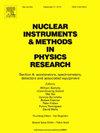Development of high-sensitivity radon emanation measurement systems with surface treatment optimization
IF 1.5
3区 物理与天体物理
Q3 INSTRUMENTS & INSTRUMENTATION
Nuclear Instruments & Methods in Physics Research Section A-accelerators Spectrometers Detectors and Associated Equipment
Pub Date : 2025-06-30
DOI:10.1016/j.nima.2025.170771
引用次数: 0
Abstract
Radon and its progenies are significant sources of background in rare event detection experiments, including dark matter searches like the PandaX-4T experiment and other rare decay studies such as neutrinoless double beta decay (NLDBD). In order to measure and control radon emanation for these experiments, we have developed two specialized radon measurement systems: a radon emanation measurement system suitable for small-sized samples with a blank rate of (stat. + syst.) mBq in the 12.3 L counting chamber, and a radon trap system designed for large-volume samples using low-temperature radon trapping techniques, which improves the sensitivity by a factor of 26 to 43 with 1 standard liter per minute (slpm) gas flow and 6 h trapping time. To boost the detection sensitivity, various surface treatments of the chambers were investigated, including mechanical polishing, electrochemical polishing, and mirror polishing, which reveals that smoother surfaces lead to lower radon emanation rates. In addition, treatments such as applying epoxy coating and covering with aluminized Mylar to stainless steel chambers can also reduce the radon emanation by and (90% C.L.), respectively.
基于表面处理优化的高灵敏度氡辐射测量系统的研制
氡及其子体是罕见事件探测实验的重要背景来源,包括暗物质搜索(如PandaX-4T实验)和其他罕见衰变研究(如中微子双β衰变(NLDBD))。为了测量和控制这些实验的氡辐射,我们开发了两种专门的氡测量系统:在12.3 L计数室中,适用于空白率为(3.16±0.75)×10−2 (stat. + system .) mBq的小体积样品的氡辐射测量系统和采用低温氡捕获技术的大体积样品的氡捕获系统,在1标准升/分钟(slpm)的气体流量和6 h的捕获时间下,灵敏度提高了26 ~ 43倍。为了提高检测灵敏度,研究了不同的表面处理方法,包括机械抛光、电化学抛光和镜面抛光,结果表明光滑的表面可以降低氡辐射率。此外,在不锈钢腔室表面涂覆环氧树脂和镀铝聚酯膜等处理也可以分别减少(90±7)%和[6,74]% (90% C.L.)的氡辐射。
本文章由计算机程序翻译,如有差异,请以英文原文为准。
求助全文
约1分钟内获得全文
求助全文
来源期刊
CiteScore
3.20
自引率
21.40%
发文量
787
审稿时长
1 months
期刊介绍:
Section A of Nuclear Instruments and Methods in Physics Research publishes papers on design, manufacturing and performance of scientific instruments with an emphasis on large scale facilities. This includes the development of particle accelerators, ion sources, beam transport systems and target arrangements as well as the use of secondary phenomena such as synchrotron radiation and free electron lasers. It also includes all types of instrumentation for the detection and spectrometry of radiations from high energy processes and nuclear decays, as well as instrumentation for experiments at nuclear reactors. Specialized electronics for nuclear and other types of spectrometry as well as computerization of measurements and control systems in this area also find their place in the A section.
Theoretical as well as experimental papers are accepted.

 求助内容:
求助内容: 应助结果提醒方式:
应助结果提醒方式:


